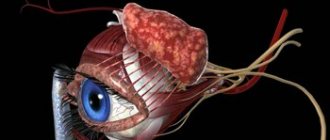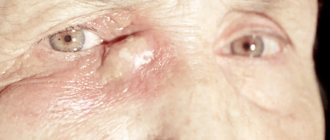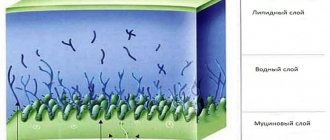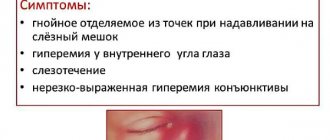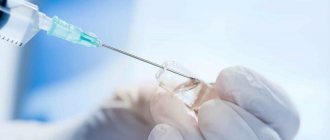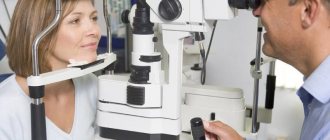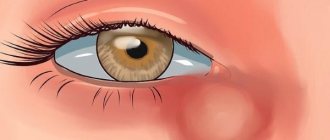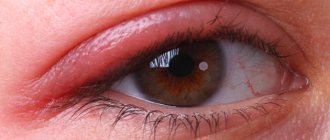Content
- 1 Diseases of the eyelids
- 2 Diseases of the lacrimal organs
- 3 Diseases of the conjunctiva
- 4 Diseases of the sclera
- 5 Diseases of the cornea
- 6 Lens diseases
- 7 Diseases of the vitreous body
- 8 Disease of the iris
- 9 Retinal diseases
- 10 Diseases of the optic nerve
- 11 Disorders of aqueous humor circulation
- 12 Diseases of the oculomotor system
- 13 Diseases of the eye socket
- 14 Refractive errors (ametropia)
- 15 Notes
Narrowing of the lacrimal opening.
Narrowing of the lacrimal opening is the most common cause of lacrimation.
Sometimes it is so narrow that it cannot be seen in side lighting. Treatment is carried out by expanding the point with a conical probe, if there is no effect - surgically. Stricture (narrowing) of the lacrimal ducts is treated in the same way.
With a long-term obstruction in the nasolacrimal duct, tear stagnation leads to stretching of the lacrimal sac and the development of pathogenic flora (streptococci, staphylococci, etc.) in the nutrient-rich tear. This leads to inflammation of the lacrimal sac - dacryocystitis.
Diseases of the eyelids
- Cryptophthalmos is a complete loss of differentiation of the eyelids.
- Coloboma of the eyelid is a full-thickness segmental defect of the eyelid.
- Ankyloblepharon - partial or complete fusion of the edges of the eyelids.
- Upper eyelid ptosis is an abnormally low position of the upper eyelid.
- Gunn's syndrome is an involuntary raising of the upper eyelid.
- Inversion of the eyelid - the edge of the eyelid is turned towards the eyeball.
- Blepharitis is inflammation of the edges of the eyelids.
- Trichiasis is abnormal eyelash growth with irritation of the eyeball.
- Edema of the eyelid is an abnormal amount of fluid in the tissues of the eyelids.
- Preseptal cellulitis is diffuse swelling of the eyelids.
- Eyelid abscess is a purulent inflammation of the eyelids.
- Stye is an inflammation of the meibomian glands at the edge of the eyelid.
- Lagophthalmos is incomplete closure of the palpebral fissure.
- Blepharospasm is an involuntary contraction of the muscles of the eyelid,
- Keratoconjunctivitis sicca - dry eye syndrome.
Diseases
Dacryocanaliculitis is an inflammatory disease of the lacrimal canaliculus. It occurs quite rarely, often secondary to inflammatory diseases of the eyes and conjunctiva. The most characteristically chronic course. The inflammatory process in the lacrimal canaliculi occurs when dust or debris gets into them. In many cases, canaliculitis is caused by fungi.
Clinic: lacrimation, purulent discharge from the medial corner of the eye, sometimes swelling and redness in the corner of the eye. When pressing on the area of the lacrimal canaliculus, purulent contents are released from the lacrimal openings.
Treatment: Surgical treatment is performed. A complication of canaliculitis may be its narrowing, stricture or obliteration.
Dacryocystitis
Dacryocystitis is a purulent inflammation of the lacrimal sac and surrounding tissue. The tear fluid stagnates in the lacrimal sac, and conditions are created for the development of infection in the lacrimal sac, however, dacryocystitis can develop without a previous infection. Since the disruption of tear outflow is permanent, dacryocystitis becomes chronic.
Clinic: lacrimation, mucopurulent discharge from the eye. The patient cannot open his eyes. Body temperature rises to high levels. Headache, weakness, weakness appear. A painful protrusion may occur in the area of the lacrimal sac. Sometimes this protrusion reaches significant sizes. When trying to rinse the lacrimal ducts, the rinsing liquid does not pass into the nasal passage.
a purulent corneal ulcer can develop which is formed due to minor mechanical damage to the cornea. At the same time, in conditions of constant existence of infection in the lacrimal sac, the corneal ulcer takes a persistent course and is difficult to treat. The occurrence of a corneal ulcer is an indication for urgent surgical treatment of dacryocystitis.
Treatment of chronic dacryocystitis .. Surgically, the lacrimal sac is dissected and an anastomosis is created between it and the nasal cavity. This operation restores the outflow of tears.
Dacryocystitis of newborns
Dacryocystitis occurs due to the fact that at the time of birth the nasal opening of the nasolacrimal duct does not open (due to developmental anomalies) and an obstacle to the outflow of tears is created. The tear fluid stagnates in the lacrimal sac. A favorable environment is created for the development of microflora. Most often, difficulty in the outflow of tears occurs when the child begins to cry tears. But sometimes, already in the first weeks of life, lacrimation and mucopurulent discharge from the eyes appear. When pressing on the area of the lacrimal sac, purulent discharge from the lacrimal openings appears. There is a slight swelling in the area of the lacrimal sac. Sometimes redness of the conjunctiva appears. When washing the lacrimal ducts, the washing liquid does not pass into the nasal passage. Treatment must be started early, otherwise the disease becomes chronic.
Anomalies in the development of the lacrimal gland.
Hypoplasia of the lacrimal gland is a hereditary anomaly characterized by underdevelopment of the gland. The extreme degree is aplasia. The clinical picture depends on the degree of preservation of the function of the lacrimal glands. With insufficient production of tear fluid or its absence, dry inflammatory processes occur in the anterior part of the eye already in childhood. Treatment consists of transplanting the parotid salivary gland into the conjunctival cavity of the duct (stenon duct). In this case, the salivary gland secretes saliva into the conjunctival cavity, the composition of which is vaguely similar to the composition of the tear fluid. The results of the operation are usually satisfactory, and vision can be preserved.
Hypertrophy of the lacrimal gland is an increase in the size of the gland, accompanied by its hyperfunction, while the patient is bothered by constant lacrimation, in addition, maceration of the skin occurs in places of lacrimation and various infections occur. Treatment consists of reducing tear production. To do this, part of the lacrimal gland is resected. It is possible to carry out diathermocoagulation or sclerosis of part of the gland.
Anomalies in the development of the lacrimal ducts.
* Pathologies of the lacrimal canaliculi (absence, narrow mouth, narrow neck). With all these developmental anomalies, lacrimation and lacrimation occur. Treatment is surgical. Plastic surgeries performed no earlier than the patient turns 14 years old. Often narrowing and closing of the lumen of the lacrimal ducts occurs after inflammatory eye diseases. Sometimes pathological changes in the lacrimal ducts develop due to iatrogenic effects. Treatment of these conditions is surgical.
* Stenosis of the nasolacrimal duct can be congenital, but much more often it occurs as a complication of a long-term inflammatory process in the lacrimal ducts. Treatment is conservative. The lacrimal ducts are washed with solutions of novocaine, dicaine, and hydrocortisone. Then the nasolacrimal duct is bougie and washed again. The course of treatment is 5-7 procedures. In case of ineffectiveness, surgical treatment is indicated
* Pathologies of lacrimal openings (absence, underdevelopment, narrowing, dislocation).
The diagnosis of anomalies of the lacrimal ducts can be made from the age of two months, since a newborn’s tear production is insignificant.
When the function of the lacrimal gland becomes more active, with anomalies in the development of the lacrimal ducts, standing tears and lacrimation occur. One of the two lacrimal openings in the eye may be underdeveloped or absent, then the developmental anomaly may go unnoticed, since there is no difficulty in the outflow of tear fluid. Treatment is surgical. After restoration of patency of the lacrimal punctum, bougienage of the lacrimal punctum is carried out within 2-3 days. In the absence of a lacrimal punctum, plastic surgery is performed to form a lacrimal punctum and connect it to the lacrimal canaliculus.
Sjögren's syndrome
Hypofunction of the lacrimal glands, or Sjogren's syndrome, is a chronic disease, the manifestation of which is a decrease in the production of tear fluid. To date, the etiology and pathogenesis of the disease have not been definitively established. There is an opinion that it is a manifestation of an allergic reaction or a type of collagenosis, possibly a neuroinfection.
In the initial stage of the disease, swelling of the conjunctiva, accumulation of transudate under the epithelium and hygroscopic degeneration of the epithelium are noted. Subsequently, the conjunctiva becomes thin and atrophies. The disease affects women over 40 years of age. As a rule, the disease begins simultaneously with the onset of menopause. Sometimes Sjogren's syndrome can occur at a younger age.
There are 3 stages of the disease:
- hyposecretion of the conjunctiva;
- dry conjunctivitis;
- dry keratoconjunctivitis.
There is a gradual onset and development of the pathological process. The disease has a chronic course with remissions. Patients complain of itching, foreign body sensation behind the eyelid, burning sensation and photophobia. When crying, no tears are produced and eye irritation is noted. A viscous secretion appears in the conjunctival sac in the form of threads, which consists of mucus and epithelial cells. They can be stretched several centimeters.
The conjunctiva of the eyelids is moderately hyperemic. Its papillary hypertrophy may be noted. The cornea in the lower part has a matte color, and in its epithelium there are numerous small round spots of gray color and focal defects. After instillation of a 1% fluorescein solution into the conjunctival sac, biomicroscopic examination can reveal subtle disturbances in the integrity of the bulbar conjunctiva and corneal epithelium. The function of the salivary glands is sharply reduced, and a reduced concentration of lysozyme is noted in the tears. Depending on how damaged the cornea is, visual acuity impairment develops. The pathological process usually develops on both sides.
After some time, the functions of other organs are disrupted. Dry skin, tongue, oral mucosa, nasopharynx and genitals appear. Dental caries and chronic polyarthritis develop. There is an increase in body temperature, changes in blood composition (eosinophilia, increased ESR, increased gamma globulin content). The function of the liver, digestive, genitourinary and cardiovascular systems is also impaired. The disease lasts quite a long time with periodic exacerbations.
To treat the disease, symptomatic therapy is used:
- instillation of fish oil, vaseline and peach oils, vitamin eye drops, 0.02% solution of furatsilin, 0.25% solution of chloramphenicol, 4% solution of taufon, polyglucin, 5% solution of α-tocopherol acetate, artificial tears, drugs Vitasik, Lakrisin, hemodesis;
- eye irrigation with 1-2.5% sodium chloride solution;
- injection into the conjunctival sac is injected with 1% syntomycin emulsion and 20% solcoseryl gel, as well as Actovegin;
- mineral and vitamin complexes, which include selenium, vitamins A, C, PP and group B;
- intramuscular administration of vitamins B1, B2, B6 and B12;
- subcutaneous injections of biostimulants (liquid aloe extract for injection, FiBS).
↑ 77. Canaliculitis
Canaliculitis is an inflammation of the lacrimal canaliculi, which is essentially a secondary process and occurs against the background of inflammatory processes of the eyelids (blepharitis, meibomitis, etc.), connective membrane (various chronic conjunctivitis, trachoma), cornea (keratitis), lacrimal gland (dacryoadenitis), lacrimal sac and nasolacrimal canal (dacryocystitis). The etiological factor is pyogenic microbes and parasitic fungi.
Manifestations
. The skin in the area of the tubules is slightly swollen, thickened, hyperemic and painful on palpation. The mouths of the lacrimal openings are hyperemic, dilated, and swollen. There is a slight mucopurulent discharge from the lacrimal openings, as well as lacrimation and lacrimation. With canaliculitis of fungal etiology, when pressing on the area of the lacrimal canaliculi, yellowish crumb-like masses are released from the lacrimal openings.
Differentiation of this cause of lacrimation and lacrimation from causes localized in the lacrimal sac or nasolacrimal canal allows diagnostic lavage of the lacrimal ducts through the second, unaffected lacrimal canaliculus.
Treatment
. Washing with antiseptics, administering antibiotic solutions or ointments, and prescribing sulfonamides are indicated.
